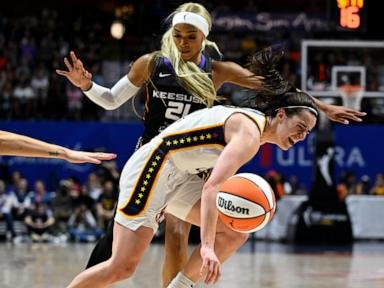The stars seemingly have aligned for the WNBA with Caitlin Clark and Angel Reese joining the ranks of A’ja Wilson, Breanna Stewart, Diana Taurasi and others.
The league is getting unparalleled attention. Now the challenge for the WNBA after opening its 28th season Tuesday night is translating the hype and hoopla into a movement and not just a moment in its history.
It’s a puzzle with various pieces: marketing strategies, fan engagement, corporate sponsors and TV deals built around intriguing basketball storylines and outsized personalities.
Minnesota coach Cheryl Reeve said everyone involved needs to be more innovative in how players and games are marketed and promoted to take advantage of the potential tsunami for both the league and women’s sports.
“If you are business as usual, if you think that the status quo is going to work, you’re going to miss out on opportunities to capitalize from a business standpoint,” Reeve said.
Taurasi agrees.
“The one thing we’ve always done as players is brought that competitive spirit and fight,” said the 19-year Phoenix guard who has seen plenty of moments where the WNBA had momentum slip through the cracks. “And now it’s their job to carry it.”
Taurasi said it feels different this time with all the attention accompanying the rookie class.
But Len Elmore, a 10-year NBA veteran who spent 31 years as a TV broadcaster, said the rookies will have to do more than just show up.
“It’s not going to help if Caitlin Clark or Angel Reese and Kamilla Cardoso don’t make the playoffs,” said Elmore, now a senior lecturer in sports management at Columbia University.
Clark debuted Tuesday night, missing her first four shots before finishing with 20 points. She also turned it over 10 times in a 92-71 road loss before a sellout crowd in Connecticut.
The NBA took off in the 1980s following the arrival of Magic Johnson and Larry Bird a couple of years ahead of a new TV deal took that league’s playoff games from being tape-delayed broadcasts to live prime-time telecasts. Both Bird and Magic went on to win multiple championships.
The WNBA’s joint deal with the NBA with ESPN is up after 2025. Ratings for women’s basketball just keep growing. Fans are so eager that they looked for — and watched — a livestream of Reese’s exhibition debut on social media.
Another key for the WNBA to emulate the success of the NBA in the 1980s is its franchises must energize local fan bases, said Mike Lewis, a professor at the Goizueta School of Business at Emory University, who studies sports marketing and sports analytics.
“One of the challenges for the WNBA is they’re now trying to build that local fandom in an era where local media has kind of died off in a lot of ways,” said Lewis, who also runs an annual fan survey called Next Generation Fandom Survey for Emory Marketing Analytics Center’s Fanalytics.
That’s where first-year stars like Clark and Reese could help build traction.
The rookies have built-in social media bases that should also help. Reese, the self-dubbed Bayou Barbie now with the Chicago Sky, has more than 476,000 followers on X alone and 3.1 million on Instagram. Clark has 2.2 million on IG.
“They’ve got a lot in front of them that potentially can be the market that they covet,” Elmore said of the WNBA’s potential reach.
Demand already has WNBA teams moving games against Clark’s Indiana Fever to bigger arenas. The two-time defending champion Las Vegas Aces became the first team in the league to sell out its allotted season tickets before a season started — back in March.
“We’ve used that tool to really expand our audience, our fans across the world,” Taurasi said of social media. “And it’s been amazing to see this rookie class really latch on to that and take it to new levels. And, you know, it’s helped … the WNBA. It’s helped college basketball. It’s really been a treat to watch.”
Corporate America also seems to sense that a WNBA movement is looming, jumping on board with individual endorsement deals for players.
— Candace Parker went from retirement to president of Adidas’ women’s basketball after her 16-year relationship with the company.
— Clark had a Nike deal announced late last month for her own signature shoe. Clark and UConn’s Paige Bueckers both got Gatorade endorsements while in college.
— Two-time MVP and Aces star A’ja Wilson just followed her new Gatorade deal by announcing her own Nike shoe A’One within the past week.
Ticket sales and viewership are up across the WNBA, and the league is expanding with new teams in California and Canada. WNBA Commissioner Cathy Engelbert said more companies are working with the league.
With all the buzz around the WNBA, Jack Silverstein, a Chicago sports historian and author of “Why We Root: Mad Obsessions of a Chicago Sports Fan,” said comparing the league to the NBA can be unfair.
Silverstein points out that the NBA has a 51-year head start over the WNBA and that new leagues and teams evolve as entertainment with their own identity, which needs momentum to keep moving.
He believes the WNBA is enjoying momentum it can build on.
“I think that when this WNBA season is over,” Silverstein said, “you could be looking at, whatever anyone thinks growth is going to look like this year, it could end up exceeding that wildly.”
___
Associated Press journalist Claire Savage, a member of the women in the workforce team, contributed reporting. The Associated Press’ women in the workforce and state government coverage receives financial support from Pivotal Ventures. AP is solely responsible for all content. Find AP’s standards for working with philanthropies, a list of supporters and funded coverage areas at AP.org.
___
AP WNBA: https://apnews.com/hub/wnba-basketball
